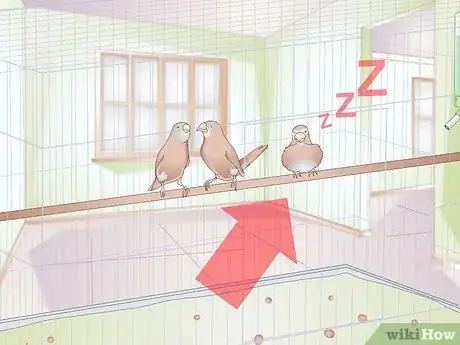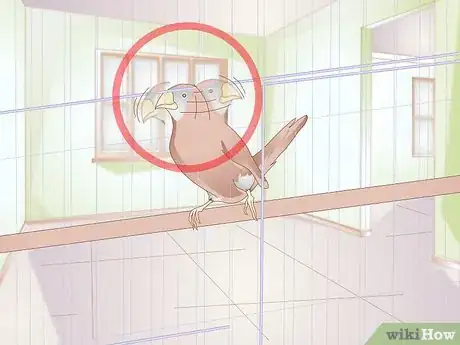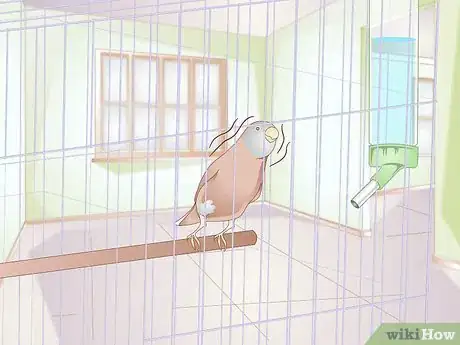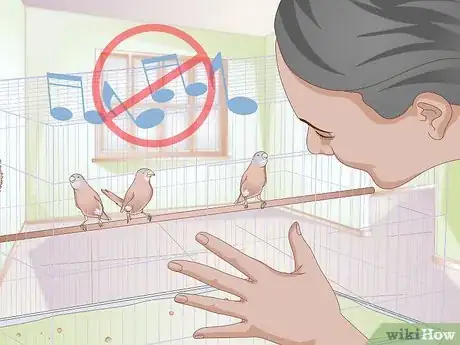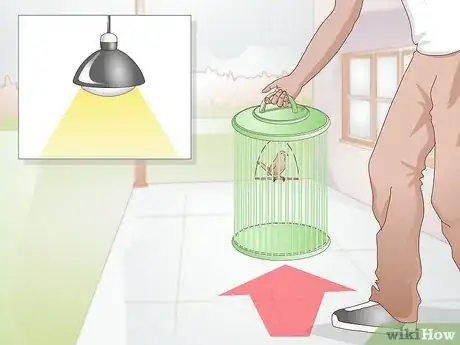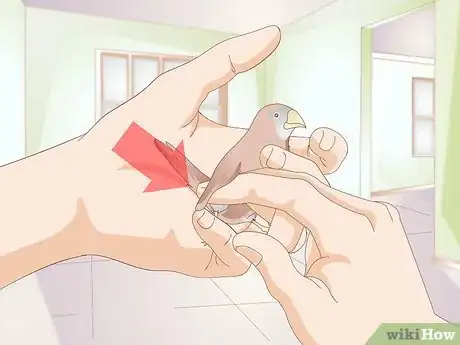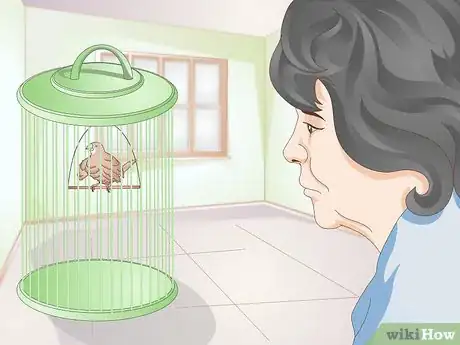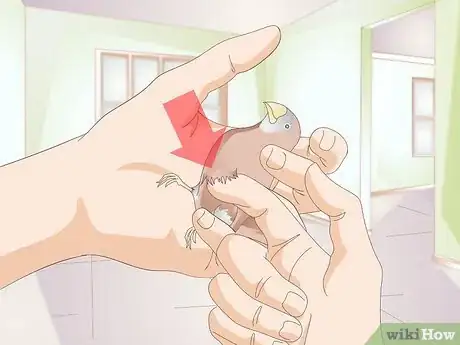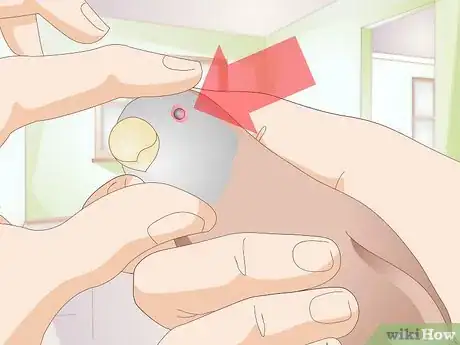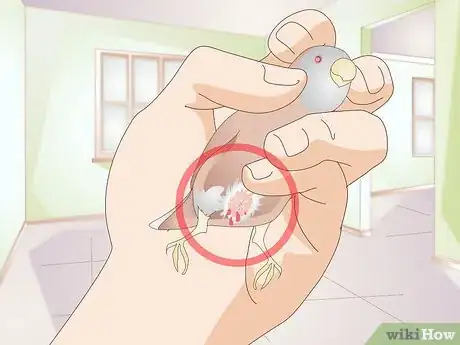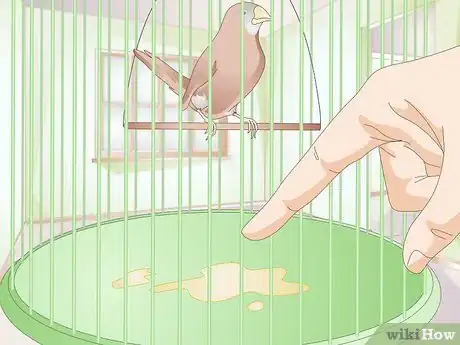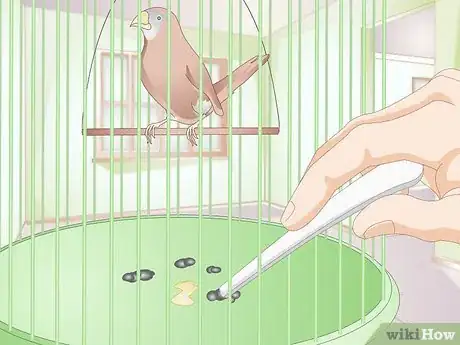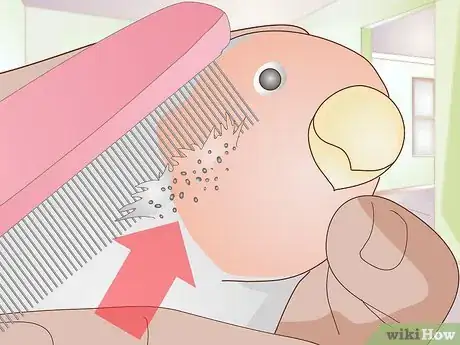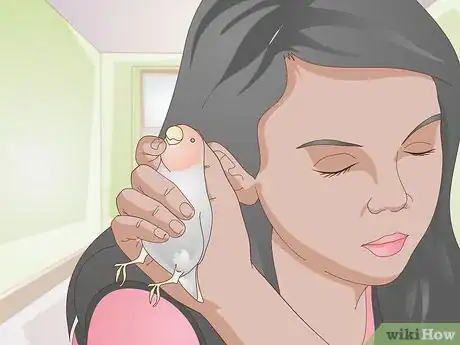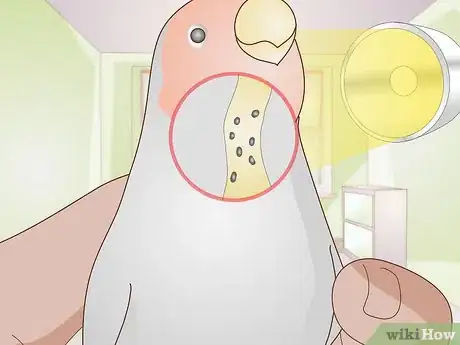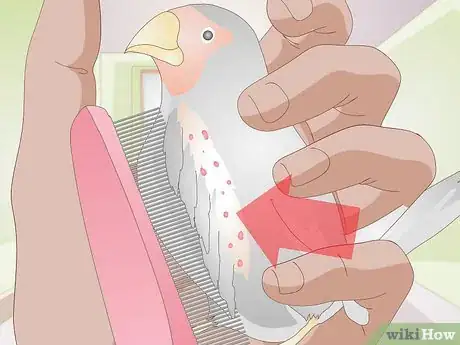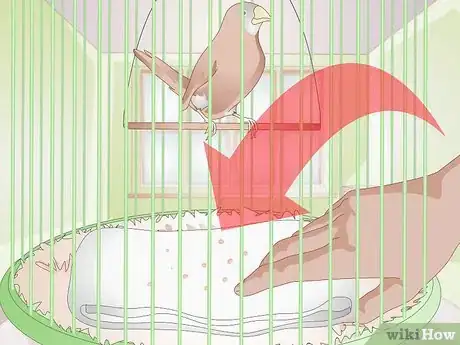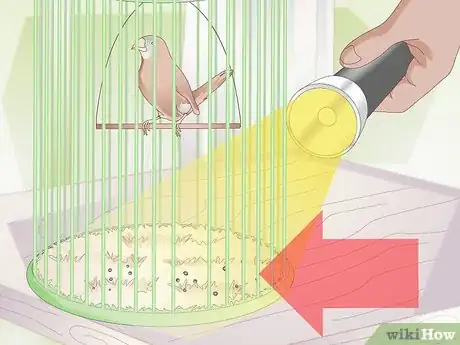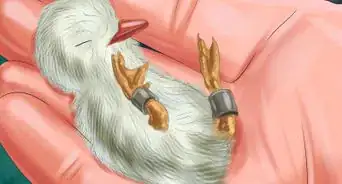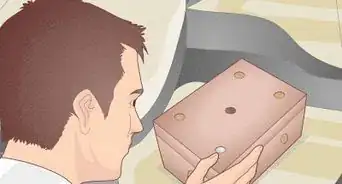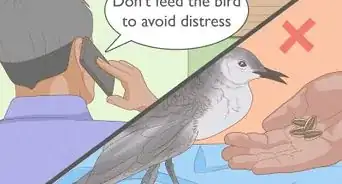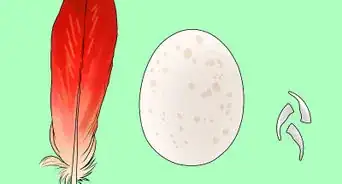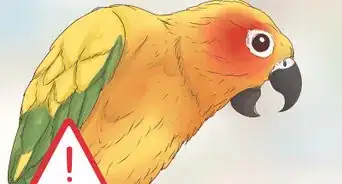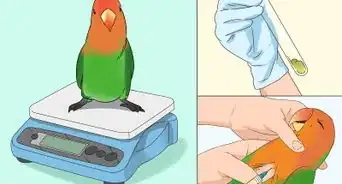This article was co-authored by Jeff Jones. Jeff Jones is a Bird Specialist based in Nashville, Tennessee. He is the writer of BirdOculars, a website dedicated to helping people become better birders. He has over 18 years of experience and specializes in feeding birds and wildlife. Jeff experiments to find ways to encourage birds he wants to study and his website help others to do the same.
There are 18 references cited in this article, which can be found at the bottom of the page.
This article has been viewed 58,183 times.
Finches are common pet birds that are vulnerable to many diseases and parasites. It is good to know your bird's behavior so that you can successfully spot when your bird is sick. Many signs of sickness are behavioral, and some diseases don't manifest physical symptoms until the late stages. By catching signs of your bird's sickness early, you may increase the chances that your bird will recover.
Steps
Observing Your Bird's Behavior
-
1Watch for excessive sleeping or lethargic behavior. While finches are normally active while awake, your finch may be drooping its head or remaining motionless on the bottom of the cage. The bird's posture may be bent or horizontal instead of vertical. If your bird is sleeping all day while all the other birds are flying around, something could be wrong.[1]
-
2Note any sneezing and coughing. Like people, birds will sometimes sneeze or cough when sick. They will often shake or twist their head as they do this. These symptoms are sometimes accompanied by nasal discharge. Also look out for heavy breathing or other signs of respiratory troubles. Your bird may have a cold, or it may be a sign of more serious problems like air sac mites.Advertisement
-
3Watch to see if other finches avoid one particular bird. Healthy house finches tend to avoid sick birds. If you have multiple finches, you may notice that they are avoiding one member of their group. If your finches have abandoned their friend, it is because they are trying to prevent getting sick themselves.[2]
-
4Monitor unusual scratching. Mites, conjunctivitis, and pox can make your bird itch. You may notice that the bird is attempting to scratch themselves with a foot or that they are rubbing up against their bird house, cage, or other objects.[3] Scratching excessively can be a sign of something wrong, and it can cause even more damage to your bird's skin.
- Normal itching will last only a few seconds, and it can be relieved with gentle rubbing. If your bird is sick, he may scratch repeatedly through the day and for several minutes at a time. He may also be scratching himself more vigorously.[4]
-
5Listen for silence. Finches are very vocal birds, so if they stop singing, something is wrong. They may be trying to conserve energy, or they may suffer from air sac mites, which cause the bird to lose their voice. If you notice that the bird has not been chirping or singing, you may want to observe for other signs of illness.[5]
-
6Move the finch's accommodations to a well-lit location. If your bird is sluggish, it may be that there is not enough light for the bird, and your finch has become depressed. Natural lighting is very important for finch health. Either provide the finch with natural light or use full-spectrum lightbulbs (also known as “daylight” or “sunlight” bulbs).[6] If the bird does not improve, the bird may be sick instead of depressed.
Examining Your Finch's Body
-
1Inspect your bird for feather loss. The loss of feathers can be a sign that the bird is stressed or sick. Healthy birds have a sleek coat that covers their entire body except for their beak, eyes, and feet.[7] Check your birds' coat for:
- Naked or bare patches
- Scaly or red skin
- Thinning feathers
- Baldness on the head
- A ruffled appearance
-
2Watch your finch for fluffed feathers. Observe your finch at a distance to observe if they are fluffing their feathers when they think they are alone. Normally, birds will keep their feathers pulled in against their bodies; this will look like a sleek coat. Healthy finches may fluff their feathers for a few minutes at a time, but a sick finch will keep their feathers fluffed much longer. They may even sleep like this. If the bird knows you are watching, however, they may pull in their feathers as a defense mechanism.[8]
-
3Feel the stomach for swelling. Gently press your fingers around the abdomen area. If you can feel a swollen belly or a hard protrusion, take the bird to a vet immediately. Egg binding is a common problem in female finches wherein the egg becomes stuck within the reproductive track and the bird cannot pass it. In addition to the swelling, your bird will be distressed, and this may look like the bird is trying to defecate. Finches can die within a few hours of egg binding.[9]
-
4Check your finch's eyes for redness or swelling. Finches are susceptible to conjunctivitis and avian pox, both of which appear on the bird's eyes. Don't touch your finch's eyes, but observe them closely. Your finch may be ill if you observe:
-
5Check the finch's vent. The water vent is where the bird excretes droppings. This will be located between the bird's tail and thighs. A healthy bird's vent will be clean and dry while a sick bird's will likely show signs of illness, including:
- Matted feathers around the vent
- Bleeding or swelling
- Discharge or wetness
-
6Inspect your bird's urine and urates for discoloration. Birds have two types of liquid waste. The clear, watery liquid is urine. The chalky white liquid is called urate. Discolored droppings are symptoms of internal diseases.
- Green or yellow urates can be a sign of either malnutrition or liver disease.
- Brown urates can be a result of lead poisoning.
- Red urine or urates can mean that your bird has internal bleeding[12]
-
7Examine the bird's feces for color and consistency. The feces should be the only solid waste coming out of your bird. Feces will be either a rusty brown color, a dark green, or the color of their food. They should also be tube-shaped, although they may come out coiled or broken up. Always keep an eye out for runny droppings or droppings of unusual colors, sizes, and textures, such as:
- Black feces
- Bright green feces
- Undigested food
- Foamy droppings
- Excessively watery feces[13]
Checking for Mites
-
1Examine the finch's skin for signs of scaly skin. Gently brush the feathers around the face to examine the skin. Various types of mites can bury into your finch's skin to lay their eggs. You may notice your finch has lesions around the face, beak, or eyes. Their skin may be coated with a white powder-like film. Feathers may be thinning in this area.
- Scaly skin can spread to their legs. You will notice a growth of crusty clumps around the foot. These can grow and accumulate until your bird can no longer walk. These growths are called tassles.
-
2Listen your finch's breathing for clicking or wheezing. If you notice your bird has labored breathing, hold your bird up close to your ear. Listen carefully for any strange noises, including clicking, wheezing, squeaking, or grunting. Such signs may be more apparent after activity such as flight. These may be a sign of air sac mites.[14]
- Even if only one bird is demonstrating these symptoms, all of your birds could be infected. Air sac mites are highly contagious, and you should treat every bird in the cage.
-
3Shine a light on their throat. Press a small light light to one side of the their throat, and examine the other side. The light will illuminate their windpipe. If you notice tiny, dark granules inside your bird's throat, it may mean that your bird is infected with air sac mites and needs immediate medical attention.[15]
- Use a small, directed flashlight beam, such as a pinpoint light. Do not shine it down their beaks, or you may blind them.
- If you suspect that your bird has air sac mites, take him to the vet for a tracheal swab. This is the only guaranteed way to prove that mites are in the airway.[16]
-
4Brush through the feathers to check for red mites. Red mites can usually be found around the crest of the bird. With your fingers, gently push back the feathers around the head of your canary. If you see tiny red specks milling around in the feathers, it is a good sign that your bird's cage has been infested.[17]
-
5Leave a white cloth in the cage to catch mites. Fold up a white or light colored cloth, and leave it in a corner of the cage overnight. During the night, when mites emerge, they may cling to the cloth. In the morning, you may notice little specks on the cloth. These are most likely mites, and their presence is a sign that the cage has been infested.[18]
- If your cage is infested, so are your birds. Even if you do not find mites directly on your birds, they are likely feeding on them if they are present in the cage.
-
6Flash a light into the cage to check for infestation. During the day, mites will often hide in the cracks of your aviary. Shine a light in the dark nooks of your bird house, taking care to sweep it through any tiny cracks or holes in the cage. Nesting boxes are a vulnerable location in the cage as well. Remove the shavings or padding on the bottom of the cage, and examine for further signs of mites.
- Mites are around 1 mm in size.
- They will form clusters of red or black bugs.
- You may see tiny dark spots moving in cracks.[19]
Warnings
- Birds can pass diseases to humans. If you think you have a sick bird, wash your hands before and after handling it.⧼thumbs_response⧽
- Nestlings and fledglings may die suddenly without displaying symptoms. Often this is classified as failure to thrive. While there could be a variety of reasons for this, the cause is often unknown.[20]⧼thumbs_response⧽
References
- ↑ https://ladygouldianfinch.com/features_sick.php
- ↑ http://phys.org/news/2012-11-house-finches-sick-members.html
- ↑ http://feederwatch.org/learn/house-finch-eye-disease/
- ↑ http://www.zebrafink.de/en/zillness.htm
- ↑ http://www.finchaviary.com/Maintenance/SignsOfIllness.htm
- ↑ https://ladygouldianfinch.com/features_light.php
- ↑ https://www.beautyofbirds.com/featherdisorders.html
- ↑ http://www.finchaviary.com/Maintenance/SignsOfIllness.htm
- ↑ http://www.peteducation.com/article.cfm?c=15+1829&aid=3060
- ↑ Jeff Jones. Bird Specialist. https://www.birdoculars.com/five-ways-avoid-house-finch-eye-disease/
- ↑ http://feederwatch.org/learn/house-finch-eye-disease/
- ↑ https://ladygouldianfinch.com/features_poopology.php
- ↑ http://www.wingwise.com/droppings.htm
- ↑ https://www.beautyofbirds.com/airsackmites.html
- ↑ https://www.beautyofbirds.com/mites.html
- ↑ https://www.beautyofbirds.com/airsackmites.html
- ↑ https://www.beautyofbirds.com/mites.html
- ↑ http://www.canaryadvisor.com/red-mites.html
- ↑ http://www.finchroom.com/articles/mites.html
- ↑ https://ladygouldianfinch.com/features_failurethrive.php
About This Article
If you think your finch might be sick, check its body for feather loss, bare patches, or red patches, which could indicate stress or sickness. Look for any unusual bleeding or swelling, especially around its stomach or eyes, your finch is probably sick. Watch out for strange behaviors, like excessive coughing, sneezing, or rubbing itself on the cage, that are common with a sick bird. If you think your finch is sick, take it to your vet as soon as you can so they can diagnose and treat it. For more tips from our Veterinary co-author, including how to check your finch for mites, read on!
